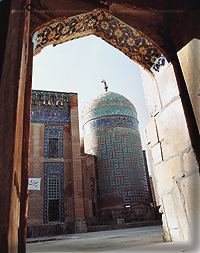Criteria i, ii, iv UNESCO region Asia-Pacific UNESCO World Heritage Site inscription 2010 | Type Cultural Reference 1345 Phone +98 914 684 1587 | |
 | ||
Hours Open today · 8AM–7:30PMIslamic Republic Day might affect these hoursSaturday(Islamic Republic Day)8AM–7:30PMHours might differSunday8AM–7:30PMMonday8AM–7:30PMTuesday8AM–7:30PMWednesday8AM–7:30PMThursday8AM–7:30PMFriday8AM–7:30PMSuggest an edit Burials Safi-ad-din Ardabili, Ismail I, Sadr al-Dīn Mūsā Similar Shorabil Lake, Sabalan, Bazaar of Tabriz, Ardabil Anthropology Museum, Chogha Zanbil | ||
Sheikh Safi al-Din Khānegāh and Shrine Ensemble (Persian: مجموعه آرامگاه و خانقاه شیخ صفی الدین) is the tomb of Sheikh Safi-ad-din Ardabili located in Ardabil, Iran. In 2010, it was registered on the UNESCO World Heritage List.
History
Sheikh Safi, an eminent leader of an Islamic Sufi order established by the Safavids, was born in Ardabil where this complex is located. The Safavids valued the tomb-mosque form, and the tomb with its mausoleum and prayer hall is located at a right angle to the mosque. The buildings in the complex surround a small inner courtyard (31 by 16 meters). The complex is entered through a long garden.
The Mausoleum of Sheikh Safi, in Ardabil, was first built by his son Sheikh Sadr al-Dīn Mūsā, after Sheikh Safi’s death in 1334. It was constructed between the beginning of the 16th century and the end of the 18th century. The mausoleum, a tall, domed circular tower decorated with blue tile and about 17 meters in height; beside it is the 17th-century Porcelain House preserving the sanctuary's ceremonial wares. Also part of the complex are many sections that have served a variety of functions over the past centuries, including a library, a mosque, a school, mausolea, a cistern, a hospital, kitchens, a bakery, and some offices. It incorporates a route to reach the shrine of the sheikh divided into seven segments, which mirror the seven stages of Sufi mysticism. Various parts of the mausoleum are separated by eight gates, which represent the eight attitudes of Sufism.
Several parts were gradually added to the main structure during the Safavid dynasty. A number of Safavid sheikhs and harems and victims of the Safavids’ battles, including the Battle of Chaldiran, have been buried at the site.
This monument is situated in the Ali-Ghapu area.
